The Intel Xeon W-3175X Review: 28 Unlocked Cores, $2999
by Ian Cutress on January 30, 2019 9:00 AM ESTCPU Performance: Rendering Tests
Rendering is often a key target for processor workloads, lending itself to a professional environment. It comes in different formats as well, from 3D rendering through rasterization, such as games, or by ray tracing, and invokes the ability of the software to manage meshes, textures, collisions, aliasing, physics (in animations), and discarding unnecessary work. Most renderers offer CPU code paths, while a few use GPUs and select environments use FPGAs or dedicated ASICs. For big studios however, CPUs are still the hardware of choice.
All of our benchmark results can also be found in our benchmark engine, Bench.
For our graphs, some of them have two values: a regular value in orange, and one in red called 'Intel Spec'. ASUS offers the option to 'open up' the power and current limits of the chip, so the CPU is still running at the same frequency but is not throttled. Despite Intel saying that they recommend 'Intel Spec', the system they sent to us to test was actually set up with the power limits opened up, and the results they provided for us to compare to internally also correlated with that setting. As a result, we're providing both sets results for our CPU tests.
Corona 1.3: Performance Render
An advanced performance based renderer for software such as 3ds Max and Cinema 4D, the Corona benchmark renders a generated scene as a standard under its 1.3 software version. Normally the GUI implementation of the benchmark shows the scene being built, and allows the user to upload the result as a ‘time to complete’.
We got in contact with the developer who gave us a command line version of the benchmark that does a direct output of results. Rather than reporting time, we report the average number of rays per second across six runs, as the performance scaling of a result per unit time is typically visually easier to understand.
The Corona benchmark website can be found at https://corona-renderer.com/benchmark
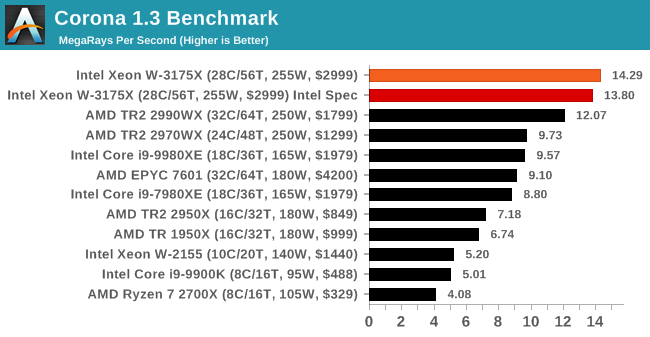
.
Blender 2.79b: 3D Creation Suite
A high profile rendering tool, Blender is open-source allowing for massive amounts of configurability, and is used by a number of high-profile animation studios worldwide. The organization recently released a Blender benchmark package, a couple of weeks after we had narrowed our Blender test for our new suite, however their test can take over an hour. For our results, we run one of the sub-tests in that suite through the command line - a standard ‘bmw27’ scene in CPU only mode, and measure the time to complete the render.
Blender can be downloaded at https://www.blender.org/download/
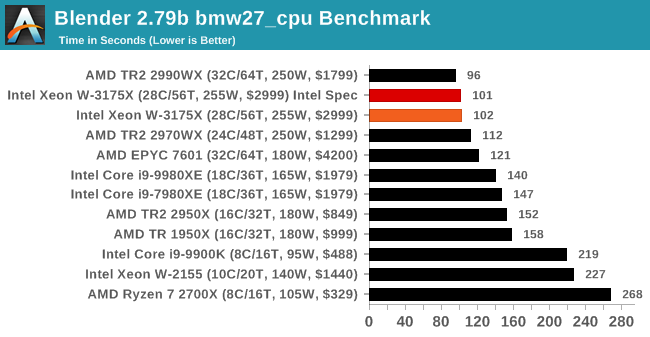
.
LuxMark v3.1: LuxRender via Different Code Paths
As stated at the top, there are many different ways to process rendering data: CPU, GPU, Accelerator, and others. On top of that, there are many frameworks and APIs in which to program, depending on how the software will be used. LuxMark, a benchmark developed using the LuxRender engine, offers several different scenes and APIs.
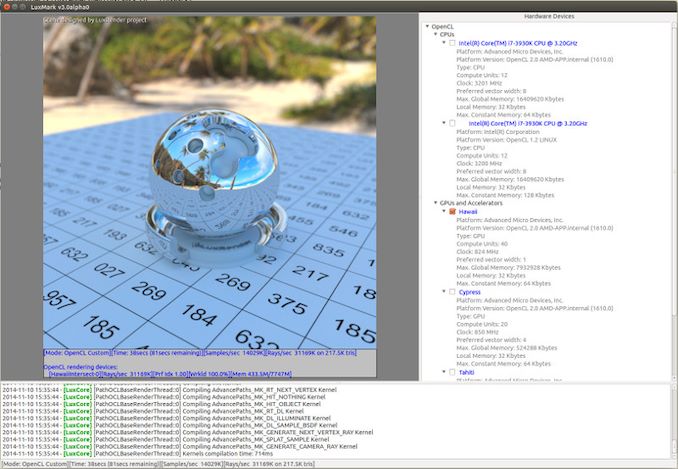
Taken from the Linux Version of LuxMark
In our test, we run the simple ‘Ball’ scene on both the C++ and OpenCL code paths, but in CPU mode. This scene starts with a rough render and slowly improves the quality over two minutes, giving a final result in what is essentially an average ‘kilorays per second’.
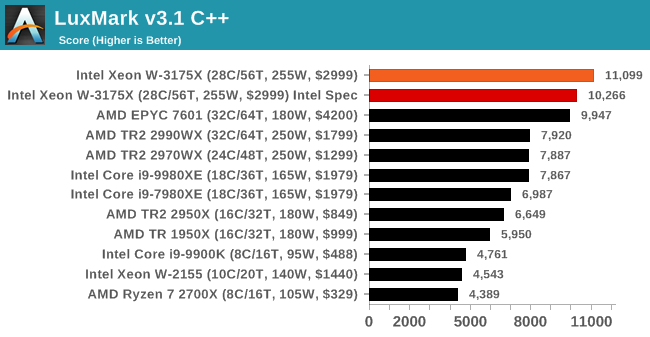
.
POV-Ray 3.7.1: Ray Tracing
The Persistence of Vision ray tracing engine is another well-known benchmarking tool, which was in a state of relative hibernation until AMD released its Zen processors, to which suddenly both Intel and AMD were submitting code to the main branch of the open source project. For our test, we use the built-in benchmark for all-cores, called from the command line.
POV-Ray can be downloaded from http://www.povray.org/
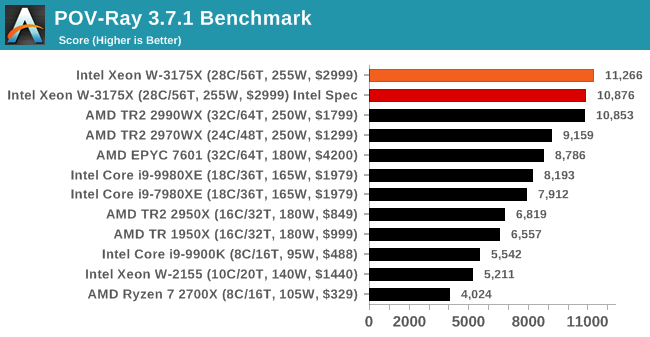
.











136 Comments
View All Comments
silverblue - Thursday, January 31, 2019 - link
Future bought the bulk of Purch not too long ago, but if it's same old same old, then I agree.Cooe - Wednesday, January 30, 2019 - link
Until these benches are all repeated in Linux all of these results are wortheless. Nobody would buy these CPU's for a Windows machine, and the 2990WX is totally borked by running in Windows as well.WasHopingForAnHonestReview - Wednesday, January 30, 2019 - link
True but the 2990WX is 1300$ cheaper and gives roughly the same performance. No one is going to buy this intel chip unless they have money to burn.maroon1 - Wednesday, January 30, 2019 - link
Same performance ?! Did you look a the benchmarks ?! w-3175x is cleary winning in majority of benchmarks (and some benchmarks should big advantage for w-3175x)I agree about price, but performance is not same
MattZN - Wednesday, January 30, 2019 - link
It depends on what precise application(s) you are running. But yes, the performance is about the same. Those benchmarks are pretty broken for a host of reasons... windows scheduler nonwithstanding, looking at a bunch of benchmarks doesn't really tell you a whole lot about how a machine will work in your actual environment.All that matters is whether the machine's performance affects your workflow in a noticeable way or not. Nobody is going to justify buying something like this if all they get out of it is a 15 minute faster encoding on a 2-hour job. Imagine that! Let alone a few seconds here and there, or a slightly slower or faster frame rate. For longer jobs you'll notice if something takes half the time. You won't notice if something is 20% slower or 20% faster. You just won't.
Many video encoding workloads are GPU accelerated, for example. Many are run as overnight batches, for example. If you go through all the benchmarks in this article, almost none of them are even remotely relevant to actual use cases. The Blender one maybe, Handbrake, and Adobe Premier and that's just about it. And surprise, surprise, the TR2950X or TR2990WX actually wins some of those.
For example, does anyone actually care how fast 7-zip runs? I sure as heck don't! I zip something up, it's well neigh instantaneous on just about any machine. Encryption? Nobody cares, it isn't a use case that anyone will notice. Office applications like spreadsheets? Come on... that's ridiculous. A 2-core mobile CPU can update a spreadsheet just as fast as one of these behemoths.
-Matt
GreenReaper - Thursday, January 31, 2019 - link
It does kinda matter for server-level ctivities. Say you have a SQL dump that you want to backup without using too much transfer. You can't run nightly backups until it's done. Even compressed it's 4GB. I use xz but it's essentially the same as 7-zip. More threads and faster threads can make a significant difference in run time, and in turn this impacts when you can backup or how much data you can handle on the system.I think you may be mistaken about the 20% difference if it effectively means you have to pay 20% more people. The question, as always, is is the price and other costs associated worth the improvement.
FMinus - Friday, February 1, 2019 - link
Why would you do any of that on this chip that sucks 600W, for all of your listed task a dedicated server chip would be better, you run them in batches over night as said, so the speed really does not matter at that point.This chip here is intended as a workstation work horse, and yes, with the price of the single chip and the expensive motherboards (which we still don't know if they will be available to the end-user directly) makes this an quite pointless platform, except if you are running Adobe Premiere 24/7.
For everything else you are better of with the cheaper AMD and Intel solutions, and you can get multiple systems of those for the price of one of these 3175X systems, split the work load or make them work together and they deliver faster results.
tamalero - Friday, February 1, 2019 - link
Not everyone has access to full blown server rendering farms. A lot of remote workers or freelancers would render with this "behemoth". Not everyone can blow 10,000 USD to have a bunch of EPYC servers just standing by.Still.. This thing doesnt seem THAT good compared to AMD's (both price, performance and power usage) to justify it.
only the AVX512 benches I guess.
But then.. Zen2 is supposed to double the output of AVX if I remember correctly.
WasHopingForAnHonestReview - Thursday, January 31, 2019 - link
7zip and some specific renders... The time saving isnt much. Its not even close to make this a worthwhile buy. When you take into account the windows scheduler bug fix coming... The amd TR for $1300 is still the obvious winner.eddman - Wednesday, January 30, 2019 - link
"No one is going to buy this intel chip unless they have money to burn."So it's not "No one" then.
I suppose 3D modeling and rendering studios or individuals that have lots of customers will probably be quite ok with buying these. That price is nothing compared to their income. They probably care more about reducing rendering time than saving a few thousand dollars, which they can recoup in probably a week or two.